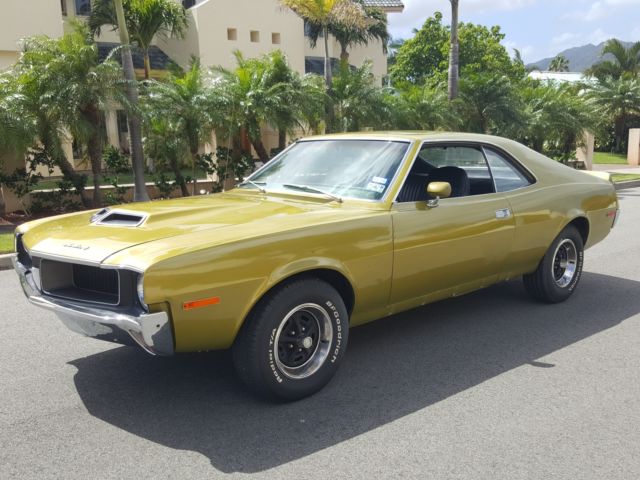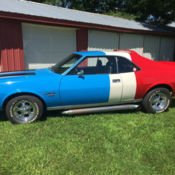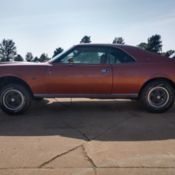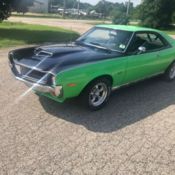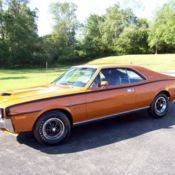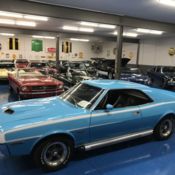1970 AMC JAVELIN SST MARK DONAHUE
Price: -
Item location: Honolulu, Hawaii, United States
Description:
1970 AMC AMX SST MARK DONAHUE
Rare 1970 Trans Am AMC Javelin SST Mark Donohue Limited Edition Factory Matching Numbers 390 cu in 325 hp 4-speed with Factory Hurst Shifter Posi Rear End Go Pack with Functional Ram Air Under 100k Original Miles 1 of 2501 Built The MD SST were only built from December ’69 - April ’70, his is one of the last ones built: production date of April 1970 Trunk 100% rust-free never any patching or repairs This car is all original except for 1 repainting Trunk 100% rust free never any patching or repairs Floor pans: ruckers are 100% Rust free no repairs 1 small surface rust bubbling on passenger side door Passenger side surface rust corner of rear window & 1 small spot on lower passenger corner panel, oor jams 100% solid super solid! Uncut unmolested 99% rust free without no patches Shipping from Hawaii to California is $1,000 tracked through Matson with an inspection Bill of Laden CALL 808 304 4160 FOR ANY QUESTIONS “American Motors didn't have deep pockets like General Motors, ord Motor Company or the Chrysler Corporation. As proof, ts fiscal windfall of nearly $12 million in 1968 represented the first time in three years that the automaker's books showed black ink. A year later, he Wisconsin concern recorded just $4.9 million in earnings. But while AMC may have lacked cash flow, t certainly didn't come up short in terms of determination and ingenuity, specially in the muscle car market. Never was this more apparent than when it was announced that AMC had pulled one of the greatest coups in domestic motorsports: signing Roger Penske and Mark Donohue for its Javelin Trans-Am racing team for the 1970 season, oaching them from Chevy's Camaro effort. It was akin to Richard Petty jumping from Plymouth to Ford a year prior. Those favoring underdog AMC were likely thrilled. Kenosha enthusiasts already knew what a properly optioned street-going Javelin offered: road-hugging handling, acy styling, ower and an affordable price tag. Donohue, ho held an engineering degree, ad been applying his skill to multiple facets of race car development. One example was the rear spoiler he designed for the Trans-Am Camaros. Although the pre-1970 race Javelin had an adjustable unit, ts design was much less effective. Reportedly, onohue revisited the design of the spoiler he'd recommended for the Camaro, nd with relatively minor alterations in dimensions, ade it an effective addition to the AMC's profile. The catch was homologation rules. AMC already had a street-legal model in the works: a corporate tri-color SST that matched the previous Peter Revson Javelins, one to rekindle interest at the dealership and reinforce the company's commitment to racing. To pacify the SCCA spoiler rules, MC announced another Trans-Am special. The Mark Donohue SST featured the new one-piece spoiler, mblazoned with his signature, n addition to other performance features: front spoiler, ide stripes, MX-style hood, o Pack and choice of 360 or 390 engine. The Donohue package added roughly $1,100 to a base V-8 SST, hich, oupled with other popular options, ften pushed sticker prices beyond $4,000. Low production was the goal. Only 2,501 were built in Kenosha, hich exceeded homologation rules by one. Like the Trans-Am Javelin, hose merits we've outlined previously (HMM #125, anuary 2014), he Mark Donohue SST is equally collectible. Yet in spite of the model's comparatively low production numbers, hey are one of the more affordable homologation specials available to collectors compared to those made by AMC's Detroit-based rivals. Here are a few other attributes you should be aware of should you find the Donohue SST tempting. ENGINES Given its racing connotations, he Donohue Javelin SST was bestowed with an ample level of power out of the gate. This eliminated the more mundane SST engine lineup--the base six-cylinder, he 304-cu.in. V-8 and two-barrel version of the 360-cu.in. V-8--while retaining the otherwise optional four-barrel 360 and 390. In this application, he 360 was listed as standard equipment. Essentially a stroked 343, t was new to AMC for 1970. The block contained a cast crankshaft and was capped by a pair of cylinder heads with 2.02/1.625-inch intake/exhaust valves and redesigned "dogleg" exhaust ports that vastly improved flow, ssisted by a true dual exhaust system. Touting a 10:1 compression ratio, t came with an Autolite 4300 four-barrel carburetor and a Ram Air induction system that, ombined with the aforementioned four-barrel, onspired to make a conservative-sounding 290 hp. While the 360 provided go-fast enthusiasts enough power to satisfy their need for torque, he better option was the 390. Released two years prior, t contained a forged crankshaft, orged connecting rods and stout 2.250-inch rod bearings. Cylinder head design was identical to the 360, s was the compression ratio. Likewise, he Ram Air system and dual exhaust were mandated; however the V-8, ith an Autolite 4300 four-barrel, as now rated for 325 hp. On paper, he 390 was second only to the same-year Camaro Z28 in terms of horsepower ratings, ut output conservatism ran rampant during this era. What to watch for: AMC's engineers had done a commendable job of designing the "second generation" V-8 engine in terms of durability and performance potential. However, any enthusiasts feel that, o protect the automaker from having to contend with warranty costs, ven the high-performance versions of AMC's V-8s tended to have mild camshaft profiles, o both the 360 and 390 engines maximize their power output below 4,000 RPM. American Motors Owners Association technical editor Jeff Reeves stated in a previous interview that the 390 has one drawback with its oiling system that restricted flow during extreme use such as drag racing; however, widely publicized oiling modification greatly relieves the issue. Both the 360 and 390 can be easily rebuilt to factory standards if needed, hile aftermarket suppliers offer upgrades that can enhance power ratings. TRANSMISSIONS Unlike the same-year Trans-Am Javelin SST, he Donohue signature editions came with a choice of transmission: Either a Borg-Warner M-11B three-speed automatic or Borg-Warner T-10 four-speed manual. Beginning with the automatic, t contained a 2.40:1 first gear ratio and, ccording to factory papers, he unit was mandated to have its shifter emerge from the center console. For those who selected the manual, he T-10 had a 2.64 first gear wide-ratio unit complemented by a Hurst Competition shifter. What to watch for: Although driving a Donohue with an automatic may be easier, he three-speed has a reputation among some serious gearheads as a unit that underperforms in muscular application; it's a good unit if you don't plan to drag race. AMC made the swap from a Borg-Warner automatic to a Chrysler TorqueFlite in 1972; however, aking it retrofit is far from an easy task. Of note, here is at least one documented Donohue SST that left the assembly line with a column-shifted version of the M-11B, ttesting to the fact that AMC did what it took to make a sale. The T-10, owever, as quite a different reputation, hat of a unit durable enough to withstand even competition driving. Finally, f a buyer happened to know the right person at the dealership, ne of two T-10 close-ratio manuals could have been installed at the assembly line. Any of these transmissions can be rebuilt with ease by specialists. CHASSIS Although AMC retained the unit-body's 109-inch wheelbase from the previous year, ll 1970 SSTs received a revised independent front suspension system that utilized upper control arms and ball joints; AMC had previously used trunnions at the spindle's upper pivot point. The front suspension was complemented by a leaf spring/hydraulic shock arrangement at the opposite end. The Donohue editions were also outfitted with the same parts as those found in the otherwise optional Go Package upgrade: heavy-duty suspension parts, ower steering, 1-inch power front disc brakes (with 10-inch rear drums), he already discussed Ram Air system, nd a limited-slip differential. That differential was AMC's Model 20, hich held a strong 87/8-inch ring gear; the limited-slip unit was known as the Twin-Grip differential in AMC parlance. Final drive ratio was based on standard SST/engine combinations; however performance gears were offered. Those savvy enough to shop via the High-Performance Group 19 parts catalog insert could have installed one of three race-friendly ratios: 4.10, .44 and 5.00:1. Rounding out the underpinnings were 14 x 6-inch AMC Magnum 500 five-spoke wheels shod with E70-14 raised white-letter bias-ply tires. What to watch for: AMC employed the Model 20 axle throughout its V-8 production--it last appeared in 1979. According to Jeff Reeves, f the splined hubs on the end of the axle shafts are not properly torqued on a regular basis, t some point a failure may occur. These can be replaced with solid one-piece axle shafts via the aftermarket. During the model year, MC began to offer 15 x 7-inch "Machine" wheels, o named for the Rebel Machine model where they were standard equipment; the larger wheels were fitted with corresponding tires for both the AMX and the Javelin. It's highly unlikely that you will find a Donohue SST fitted with them from the factory. BODY & INTERIOR AMC had refreshed the Javelin for the 1970 season, ringing it closer in appearance to the AMX. All the hallmarks of the upgraded SST trim were retained, ut the grille was blacked out. Visual cues that set the base SST apart from the Donohue editions were the Ram Air hood, ide stripes, ront spoiler and, f course, he one-piece "ducktail" spoiler mounted to the decklid. The exterior color palette was not limited--your Donohue could have been painted in any color offered in '70--and if desired, vinyl top was offered. Like Trans-Am Javelin, he interior of a Donohue SST did not receive any special badges or trim. Bucket seats were standard while the 140-MPH speedometer and 8,000-RPM tachometer were highlighted by the SST's woodgrain surround. A two-spoke steering wheel was standard, lthough a Sport Steering wheel was optional, s was air conditioning, hoice of radio and power windows. What to watch for: Unfortunately, he Donohue SST can easily be replicated. All the necessary components, ncluding the rear spoiler, ere available through AMC's Group 19 program, nabling both dealers and customers to create the same vibe on a base SST. Compounding the issue is the fact that AMC did not issue a separate VIN or fender tag denoting the effort. Proving the existence of a factory-original boils down to whether or not previous owners retained any factory paperwork. Eddie Stakes of planethouston- amx.com recommends that anyone considering the purchase of a Donohue SST inspect the quarter panels, he sill panel between the rear window and trunk lid, nd the lower portion of each A-pillar. Panel designs led to poor drainage if debris was permitted to accumulate in these areas. Trunk and floorpans should also be inspected. RESTORATION & PERFORMANCE PARTS As AMC's popularity with enthusiasts continues to increase, ore reproduction restoration parts have become available as existing NOS part supplies dwindle. Floorpan sections, ocker panels, runk pans and rear quarter patch panels are obtainable, nd although some fiberglass panels that cross the Javelin/AMX lines are now offered, ost restorers prefer steel. Used panels in good condition still exist, lthough supplies are shrinking. The list of interior replacement parts is growing too, hile--like many muscle cars--mechanical components have never really been in short supply. Original AMC Group 19 parts can be found, ut are exceedingly rare. That said, he front and rear spoilers are reproduced, hile items such as custom camshafts, ftermarket intakes and carburetors can spice up the AMC's performance. ENGINE According to factory ads announcing the model, he Mark Donohue signature-edition SST was available with either a 360- or 390-cu.in. engine, ach equipped with a four-barrel carburetor, nd made 290 and 325 hp, espectively. BRAKES Engineers shelved the Javelin's standard drum-brake system in favor of the otherwise optional power front disc equipment. Four-piston calipers accompanied the 11-inch rotors. Cast-iron 10-inch drums remained behind the rear wheels. TRANSMISSION According to mandates originally set forth by AMC, he Donohue SST was supposed to be available with a console-shifted three-speed automatic or a four-speed manual, oth from Borg-Warner, lthough at least one came with a column-shift automatic. INTERIOR Donohue Javelins were based upon the more plush SST, nd therefore received its standard vinyl bucket seat interior; all of them were finished in black. Included were a 140-MPH speedometer and an 8,000-RPM tachometer. CHASSIS There was little in the way of change to the 109-inch-wheelbase unit-body chassis of the SST from the previous year; however, he Donohue editions did receive Go Package equipment, ncluding heavy-duty suspension upgrades and power steering. BODY The body was slightly redesigned for the 1970 model year. A blacked-out grille was complemented by a front spoiler, ucted hood and Donohue-designed rear spoiler that this car homologated for racing in SCCA's Trans-Am series.” —Hemmings.com—Vehicle Details:
- Condition: Used
- Make: AMC
- Model: AMX
- SubModel: SST MARK DONAHUE
- Type: Coupe
- Trim: CHROME
- Year: 1970
- Mileage: 98,976
- VIN: A0CC797P243951
- Color: Gold
- Engine size: 390
- Number of cylinders: 8
- Fuel: Gasoline
- Transmission: Manual
- Interior color: BLACK
- Vehicle Title: Clear Want to buy? Contact seller!
